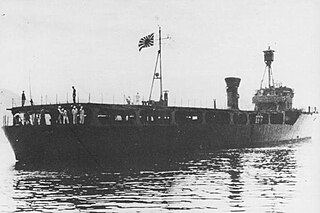
A cruiser is a type of warship. Modern cruisers are generally the largest ships in a fleet after aircraft carriers and amphibious assault ships, and can usually perform several roles.
The escort carrier or escort aircraft carrier, also called a "jeep carrier" or "baby flattop" in the United States Navy (USN) or "Woolworth Carrier" by the Royal Navy, was a small and slow type of aircraft carrier used by the Royal Navy, the Royal Canadian Navy, the United States Navy, the Imperial Japanese Navy and Imperial Japanese Army Air Force in World War II. They were typically half the length and a third the displacement of larger fleet carriers, slower, more-lightly armed and armored, and carried fewer planes. Escort carriers were most often built upon a commercial ship hull, so they were cheaper and could be built quickly. This was their principal advantage as they could be completed in greater numbers as a stop-gap when fleet carriers were scarce. However, the lack of protection made escort carriers particularly vulnerable, and several were sunk with great loss of life. The light carrier was a similar concept to the escort carrier in most respects, but was fast enough to operate alongside fleet carriers.

Destroyer escort (DE) was the United States Navy mid-20th-century classification for a 20-knot warship designed with the endurance necessary to escort mid-ocean convoys of merchant marine ships.

A submarine chaser or subchaser is a small naval vessel that is specifically intended for anti-submarine warfare. Many of the American submarine chasers used in World War I found their way to Allied nations by way of Lend-Lease in World War II.

Shikinami was the 12th of 24 Fubuki-class destroyers, built for the Imperial Japanese Navy following World War I. When introduced into service, these ships were the most powerful destroyers in the world. They served as first-line destroyers through the 1930s, and remained formidable weapons systems well into the Pacific War.

Hatsuharu, the second Imperial Japanese Navy destroyer of the name, was the lead ship of six Hatsuharu-class destroyers built under the Circle One Program. Three were laid down in JFY 1931 and the next three in JFY 1933. The remaining six ships in the plan were built as the Shiratsuyu class.

The Shimushu-class escort ships were a class of kaibōkan built for the Imperial Japanese Navy just prior to World War II. Four ships out of an initially planned 16 vessels were completed. The class was also referred to by internal Japanese documents as the "A-class" coastal defense vessel.

The Momo-class destroyer consisted of four destroyers built for the Imperial Japanese Navy during World War I. As with the previous Kaba class, all were named after trees.

Akikaze was a Minekaze-class destroyer, built for the Imperial Japanese Navy immediately following the end of World War I. The Minekaze class of destroyers were considered advanced for their time; these ships served as first-line destroyers through the 1930s. The class was considered obsolete by the start of the Pacific War and served in a number of roles including minesweeper, aircraft rescue ships and Kaiten-carriers.

Shiokaze was a Minekaze-class destroyer, built for the Imperial Japanese Navy immediately following World War I. Advanced for their time, these ships served as first-line destroyers through the 1930s, but were considered obsolescent by the start of the Pacific War.

Yūkaze was a Minekaze-class destroyer, built for the Imperial Japanese Navy immediately following World War I. Advanced for their time, these ships served as first-line destroyers through the 1930s, but were considered obsolescent by the start of the Pacific War.

Hokaze was a Minekaze-class destroyer, built for the Imperial Japanese Navy immediately following World War I. Advanced for their time, these ships served as first-line destroyers through the 1930s, but were considered obsolescent by the start of the Pacific War.

Tachikaze was a Minekaze-class destroyer, built for the Imperial Japanese Navy immediately following World War I. Advanced for their time, these ships served as first-line destroyers through the 1930s, but were considered obsolescent by the start of the Pacific War.

The Wakatake-class destroyers were a class of eight second-class destroyers of the Imperial Japanese Navy.

Uzuki was one of twelve Mutsuki-class destroyers built for the Imperial Japanese Navy (IJN) during the 1920s. During the Pacific War, she participated in the Battle of Wake Island in December 1941 and the occupations of New Guinea and the Solomon Islands in early 1942.

The Type C escort ships were a class of escort ships in the service of the Imperial Japanese Navy during World War II. The Japanese called them "Type C" ocean defense ships, and they were the fifth class of Kaibōkan, a name used to denote a multi-purpose vessel.

Kaibōkan or coastal defense ship was a type of naval ship used by the Imperial Japanese Navy during World War II for escort duty and coastal defense. The term escort ship was used by the United States Navy to describe this category of Japanese ships.

The Hakachi (波勝) was a bomb target ship of the Imperial Japanese Navy (IJN) serving during the Second World War, the only ship of her class.
Destroyer escort is the US Navy classification for a smaller, lightly armed warship designed to be used to escort convoys of merchant marine ships.

Kiri was one of 18 Matsu-class escort destroyers built for the Imperial Japanese Navy (IJN) during World War II. Completed in mid-1944, the ship played a minor role in the Battle off Cape Engaño in October and began escorting convoys the following month. She was moderately damaged by American aircraft while escorting a troop convoy in December. Kiri returned to Japan in January 1945 for repairs and escorted a convoy to Japanese Formosa later that month. Her activities for the rest of the war are unknown.

















